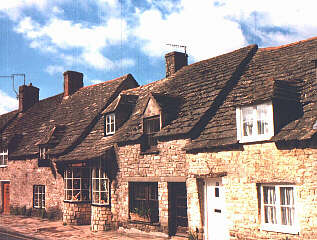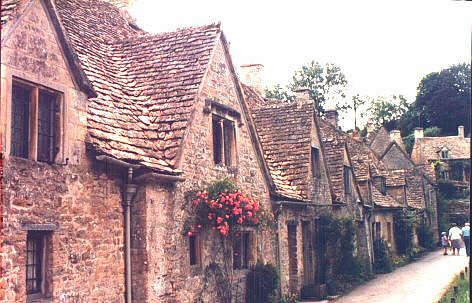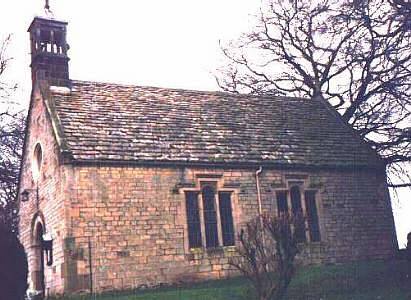| STONE ROOFING ASSOCIATION | |
| Home > Start > Contents > A Tour of the Stone Slate Regions > Jurassic |
| STONE ROOFING ASSOCIATION | |
| Home > Start > Contents > A Tour of the Stone Slate Regions > Jurassic |
| A TOUR OF THE STONE SLATE REGIONS | ||||||||||||||||||||
|
|
||||||||||||||||||||
| The limestone slates (and the sandy limestones) are found in a broad sweep from Portland and the Isle of Purbeck in Dorset to the Howardian Hills in east Yorkshire. They include the famous Forest Marble, Stonesfield and Collyweston stone slates of the south central counties as well as the less well known types from Duston near Northampton, and the Brandsby Roadstone east of Thirsk in the Scarborough Limestone Formation. All of these are in the Jurassic formations of the Upper and Lower Oolite. The Corallian and the Lias have also been worked for roofing. | ||||||||||||||||||||
| GEOLOGY
The Jurassic is divided into three main units: the Upper, Middle and the Lower. The Middle is subdivided into the Great and the the Inferior (meaning lower) Oolite. Within these divisions there are many named rocks some of which are not laterally continuous. Most of the rocks have produced stone-slates somewhere. |
||||||||||||||||||||
|
||||||||||||||||||||
| PURBECK
The Isles of Purbeck and Portland have been quarrying centres since at least Roman times and both contain fissile rock suitable for roofing. Although Lower Purbeck Beds in Portland were no doubt put to this purpose it is the Middle Purbeck Beds on the Isle of Purbeck which are best known. Here the Downs Vein was the most productive and has the best reputation for durability but the Wetsom and Thornback veins also split thin enough from time to time. Roofing was never a large part of the production and judging by the extent of stone roofed houses in the region the amount produced was probably always small and intermittent. This is certainly the case today and there is a constant problem obtaining new slates. |
||||||||||||||||||||
| John Palmer has carried out some interesting research on Purbeck roofs, quarries and archeology during the Roman period. | ||||||||||||||||||||
| Purbecks are amongst the largest of the British limestone-slates. When newly laid they are creamy yellow and when a roof has been relayed with a mixture of new and old slates it produces a chequered effect, but they soon weather to an overall grey colour. When using new slates it is important to allow them to stand for some time before putting them on the roof otherwise they can be damaged by frost. | ||||||||||||||||||||
 |
||||||||||||||||||||
| The roofs are generally simple in plan but frequently contain dormers often with the windows carried through the eaves. The dormers can be monopitched, gabled or hipped and valleys are mitred with lead soakers often pointed with mortar to hide the lead. Mortar has been used traditionally to help the rough slates sit without rocking and to fill large gaps but it should not be visible. Many of the roofs seen today are spoiled by excessive and exposed bedding and pointing. Saddles are traditionally weathered with an upturned ridge - stone or clay but these are now often replaced with large, ugly lead flashings which are badly installed. | ||||||||||||||||||||
| Lead is also badly used to weather abutments and the cheeks of dormers. Traditionally the former would have been mortared and the large cover flashings to be seen now on many buildings are both unsightly and technically incorrect. The best modern detail would be to use a mortar flashing over lead soakers. Dormer cheeks should be covered with cut to size stone panels - which are readily available – over soakers. | ||||||||||||||||||||
 |
||||||||||||||||||||
| DORSET,
SOMERSET, WITSHIRE, GLOUCESTERSHIRE, OXFORDSHIRE. THE COTSWOLDS
The stone-slates of this region exhibit a variety of lithologies including fissile, fine-grained oolites, sandy limestones; calcareous fine-grained quartzose sandstones and siltstones. Two broad types of stone-slates are recognised in the Cotswold area of south central England: Presents and Pendle. |
||||||||||||||||||||
| Presents are are found in near surface deposits which have been subjected to peri-glacial and post-glacial weathering. They are found pre-split or are easily spilt with a chisel and are then sorted, trimmed to size and shape and holed. They have been produced in a broad area from Wiltshire through parts of Gloucestershire and Oxford from a variety of units including the Chipping Norton Limestone, the Hampen Marly and the Sharp’s Hill Beds and the Forest Marble. | ||||||||||||||||||||
| Presents are generally small, uneven and heavy producing a highly textured roof. Pendle slates are obtained from deeper, unweathered beds and are split be frost action after mining. The stone was stored underground or reburied until a good frost promised. Several frost cycles are necessary to complete the process following which the layers are prised apart and the edges trimmed to size. The main centre for frost split slates in the Cotswolds was at Stonesfield in the Taynton Stone but similar stone was worked at Througham and Eyford and the same process was used at Collyweston in Northamptonshire. They are hardly produced today because natural frosts cannot be relied on but an artificial process is being researched. They are a similar size to pendle but are often thinner and flatter. | ||||||||||||||||||||
| Because of their size and shape they both slate types can be readily laid into curves and this has lead to the development of the distinctive Cotswold swept valleys. Equally attractive are the laced valleys with are more common towards Northampton and the other Collyweston counties. Dormers are most often gabled although hips are locally common. Throughout the limestone regions the junction between the dormer ridge and the main slope was traditionally weathered with an upturned stone ridge tile. This detail should always been retained with a discrete lead soaker for added security. | ||||||||||||||||||||
 Top |
||||||||||||||||||||
| EAST
MIDLANDS
In Northamptonshire slatestones are found in the Middle Lias, Northampton Sand, and the Lincolnshire, Upper Estuarine and Blisworth Limestones. Of these, production of only the frost split Collyweston Slate in the Lincolnshire Limestone has persisted into the present day and even this has almost slate ceased production. Its future like the Stonesfield of the Cotswolds is dependent on the development of an artificial frosting process. The process of frosting and making Collyweston slates was described by Judd in 1875. Roofs are normally steeper than 45 degrees which is important for shouldered slates which reduce to narrow sizes, to ensure water does not pass the side lap. Hipped roofs are rare but hipped dormers are often seen. Gables are finished by carrying the slates over the wall and forming a mortar fillet underneath, or with copings which may be immediately on the slates or raised above and the slates butted up with a fall towards the roof slope. The abutment is weathered with lead soakers and mortar flashing. Dormers are common and are often carried below the eaves. They may be gabled or hipped. Valleys when traditionally executed are laced. Dormer ridges are often carried up into the slope above. Ridges are stone or clay tiles. The roofs are generally formed with mortar and this is a long established practice. A slate recovered from an archaeological site dating from not later than the 15th century was found to have been mortared and laid at one third lap. The mortar is used to bed the slates (spot bedding) and, where there is a gap between slates in successive courses, shales are inserted in the bedding. Shales are also used to help weather a slate with, for example, an excessive shoulder. There is disagreement about the wisdom of this – whether it is tradition, a necessity or bad workmanship. Whichever is the case, it is common practice. It is also common practice to tail bed slates and mortar the perpendicular joints. It is claimed that this is traditional in the region and the archaeological evidence suggests that it is a long-standing practice. Nonetheless it is technically undesirable and does not improve the appearance of the roof, but it is not known whether it has actually resulted in roof failure or premature deterioration. |
||||||||||||||||||||
| YORKSHIRE
Yorkshire is mainly known for its Carboniferous sandstone slates but before the railways revolutionised the transport of roadstone there were many small quarries which supplied their immediate neighbourhood. One group existed in the limestone belt south of the North York Moors. Known as Brandsby Roadstone it lies at the northernmost limit of the Jurassic limestones and is part of the Scarborough Formation (previously known as the Grey Limestone Series). Some of the levels in the quarries were fissile and the area became an island of stone roofs in a sea of clay pantiles. |
||||||||||||||||||||
 |
||||||||||||||||||||
| Unfortunately by 1892 Fox-Strangways in his report on the Jurassic Rocks of Yorkshire had to report that ‘the Brandsby Roadstone which was formerly extensively quarried in the western part of the Howardian Hills between Brandsby and Gilling;’ had ‘since the introduction of railways, been largely superseded by whinstone.’ | ||||||||||||||||||||
| No doubt they continued to produce roofing, flagging and walling for some time but ultimately the industry died out and roofs are now repaired or renewed with Carboniferous sandstone from Yorkshire or county Durham or clay pantiles. Many roofs now have one slope of Brandsby and others of sandstone, or Brandsby stone at the eaves with pantiles above. | ||||||||||||||||||||
| LIAS LIMESTONES | ||||||||||||||||||||
| SOMERSET
- HAM HILL
At Ham Hill roofing stone was obtained from quarries which have existed from at least Saxon times. This is now a protected site The limestone beds near the surface had been rendered fissile by peri-glacial action. |
||||||||||||||||||||
|
||||||||||||||||||||
| South of the Saxon quarry there are two faults which have downthrown the roofing beds and they are found near the bottom of the present quarry where they are too compact to be suitable for splitting. It is possible that surface deposits will yield some roofing as they are quarried in the future. | ||||||||||||||||||||
| OTHER
LIAS ROOFING?
There are intriguing references to the use of Lower Lias for roofing in Somerset, Herefordshire and Shropshire, but no examples are known on roofs. If anyone has any information on their use please let me know. |
||||||||||||||||||||
| QUEEN
CAMEL
Woodward (1893) recorded 'Some of the Lower Lias limestones at Queen Camel, near Sparkford, have yielded thin stone-tiles that were used for roofing; and beds near Burley Dam in Shropshire were at one time quarried for similar purposes. Unfortunately he gives no further information. There is also a suggestion that the Lias was worked for roofing in the Charlton Mackeral and Charlton Adam area but it has not been possible to confirm this. Near Somerton, Station Quarry at Charlton Mackeral and Tout Quarry at Charlton Adam are working the Lower Lias and Blue Lias but do not produce roofing. |
||||||||||||||||||||
| HEREFORDSHIRE
It is possible that stone from the base of the Lias was used for roofing at Ashleworth and around Tewkesbury. Suitable stone has been found in field walls in the area although at present no examples are known on roofs. There are records of old quarries at Sarn Hill, Hill Croombe and Heath Hill near Tewkesbury (Richardson 1904, 36--41) which are all within a mile or two of the River Severn which would have provided an easy route to Ashleworth. Murchison (1839, 21) recorded the colloquial names of the six beds quarried in the area: Top, Black, Tile, Poacher, Peaver and Bottom. Unfortunately, as is so often the case, it isn’t clear whether Tile implies a roofing or flooring application. He also noted ‘In descending order we first perceive about 12 thin courses of dark-coloured calcareous flagstones, which are extracted for roads, paving, building, and burning to lime. These courses vary in thickness from 1 to 3 inches, and are separated from each other by stiff marl’ (Murchison 1839, 20). Other exposures of the rock indicate that the stone could have been worked along both sides of the river from north of Tewsbury southwards to at least Ashleworth (Thanks to David Jefferson and Graham Lott for help in researching this one.) |
||||||||||||||||||||
| SHROPSHIRE
Jurassic in the Welsh Marches Howe (317-318) reported a source of stone-slates from the Lower Lias at Burley Dam east of Whitchurch in Cheshire. He was probably quoting Murchison who stated ‘In the vicinity of Burley Dam, some of the [Lower Lias] beds are so hard as to have induced Lord Combermere to quarry them for slating purposes’ (Murchison 1839, 23). Whatever the intentions of Lord Combermere there is no Lias roofing at Combermere Abbey now (Gerald Emerton pers comm). So it has to be assumed for the present that the initiative either came to nothing or the slates failed soon after being quarried and were replaced. |
|
|
|
|
|